Hyper-flexion Jean Luc Cornille Article
Hyperflexion
Hyperflexion of the Upper Neck,
Work of the Nuchal Ligament
A Failure of Olympic Dimension
Instead of upgrading their equestrian education to the quality level of their horses, riders and trainers practicing the hyperflexion of the upper neck are downgrading their horses to ultimate domination by placing their horse in a situation where they have physically no way out.
This is a failure of Olympic dimension. Submissive techniques belong to the equestrian education of the medieval age.
A major obstacle, however, needs to be eradicated: an erroneous theory, which like a drug is feeding the dream that one will be winning while simultaneously destroying the partner without which one cannot win. No hope can be expected from the governing body. The F.E.I. has been efficiently lobbied and, in regard of hyper-flexion of the horse’s upper neck has taken a non-committed position. The awkwardness and discomfort of the horses’ body language have disgusted practically every rider and trainer possessing ethics and decency.
However one looks at it: from the perspective of the main ligaments involved, the muscular system, the kinematics of the limbs, or the biomechanical properties of the vertebral column, there is no advantage in over-flexing the horse’s upper neck.
The nuchal ligament is an elastic structure inserted at one end on the dorsal spinous process of the fourth thoracic vertebra and attached at the other end on the cervical vertebrae and the skull.
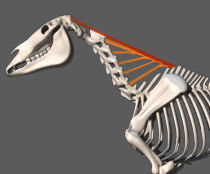
The general consensus is that the nuchal ligament supports the head in an alert position, yet stretches enough to allow grazing.
In reality, in reality the opposite is true, the nuchal ligament is not under tension when the horse holds the head and neck in an alert posture.
At the other extreme, the nuchal ligament is not elastic enough to allow grazing. Instead of the support role theorized by traditional anatomists, the purpose of the nuchal ligament is to assist the work of the upper neck muscles. At the walk, the nuchal ligament provides an amazing 55% of the energy needed to move the head and neck. At the trot and canter, the nuchal ligament assumes 33% and 31% respectively of the total work required to oscillate the head and neck. By taking advantage of the nuchal ligament’s energy storage capacity, the horse reduces the work of the upper neck muscles between 31% and 55% at the different gaits.
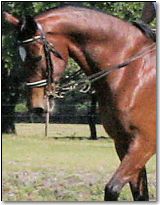
The head and neck carriage commonly presented at FEI dressage level is totally assumed by the work of the upper neck muscles. The nuchal ligament is then almost totally unstrained. “At a neck angle of 55ºall portions of the nuchal ligament are unstrained.” (K. S. Gellman, J. E. A. Bertram, The Equine Nuchal Ligament: Structural and Materials Properties, 2002).
The lowering of the neck that the horse spontaneously executes after work is not a stretching of the upper neck muscles as emphasized by traditional anatomist, but rather an astute way to ease the work of the upper neck muscles, thereby increasing the contribution of the nuchal ligament. So when a horse relaxes and lowers his head, he is giving his neck muscles a rest by changing his head and neck position which in turn means the nuchal ligament is now active.

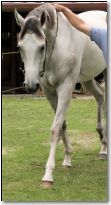
The principle of storage and restitution of energy that is commonly accepted in respect of the long tendons and ligaments of the horse’s lower legs, applies within the neck to the nuchal ligament. Large animals such as the horse cannot function on the simplistic concepts of muscles moving bones.
It would require enormous muscle masse and tremendous muscular energy to move the horse’s limbs and body. Instead, the horse has developed a sophisticated mechanism of short muscles assuming optimum elastic recoil of long tendons, which in turn are moving the legs. It is this elastic recoil effect that reduces and enhances the work of the muscles.
The horse’s energy saving mechanism does not apply only to the lower legs. In fact the fore limbs, all the way to the muscles supporting the trunk from the shoulder blades; the hind limbs, all the way to the pelvis; and the whole vertebral column mechanism, as well as the neck, are constructed on the model of energy saving and energy restitution.
In order to measure the strain energy storage capacity of the nuchal ligament, the two researchers from Cornell University, investigated the material and structural properties of the ligament. Observing differences in density and volume from the attachment of the nuchal ligament on the withers area by comparison to the insertion on the skull, Gellman and Bertram divided the funicular element into four equal parts.
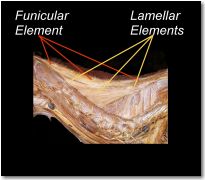
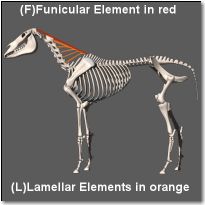
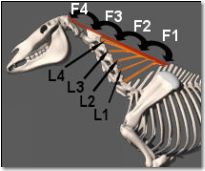
The nuchal ligament consists of a dorsal cord-like section that is referred to as funicular (F) and a sheet-like section that is named lamellar (L). The lamellar elements spread between the funicular elements and the cervical vertebrae.
The two scientists observed that the two segments labeled on our illustration as F3 and F4 had little tissue volume. “These portions have been neglected from the reminder of the analysis because it is doubtful that they store a useful quantity of elastic energy.” (Gellman, Bertram) These sections, which are too weak to even be considered in a scientific investigation, are the portions that are placed under intense strain when the upper end of the neck is overly flexed!!!
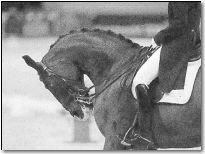
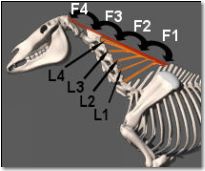
The research lead to a significant discovery. Even if, from an anatomical perspective, the nuchal ligament spreads from the spinous processes of the more advanced thoracic vertebrae to the skull, the nuchal ligament functions in fact from the dorsal spines of the cranial thoracic vertebrae to the back of the second cervical vertebra. “Functional load bearing, in the equine nuchal ligament, passes from its origin on the cranial thoracic spinous processes though the nuchal ligament regions F-1 and F-2, then to region L-4, inserting on the second cervical vertebrae.” (Gellman, Bertram)
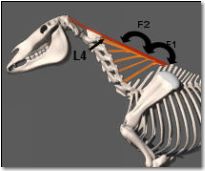
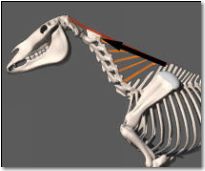
The black arrow illustrates the line of function of the nuchal ligament.
Whatever hyperflexion of the upper neck is achieved in the warm up of a dressage ring or with draw reins in the warm up of a jumping ring, the “technique” is acting on a section of the horse’s neck that has very little tissue volume and therefore is incapable to sustain increased stress and is even not active in the horse’s locomotion!!!
Le line of function
Whatever the neck posture, the cervical vertebrae are always aligned into a deformable S shape.
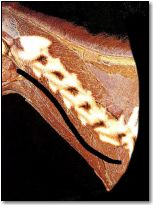
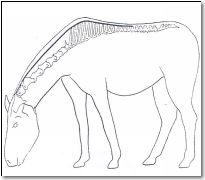
“Virgchow, 1915 has already pointed out that in the dorsal direction (ventral concave) the cervical vertebral column can be stretched only so far, that the vertebrae are lying in a straight line. A further dorsal flexion is chiefly prevented by the ligaments. Thus the fact that the Ungulates with their long necks can reach the ground with their mouth, is not based on the mobility of the neck. It is made possible by the mobility of the thoracic vertebrae, by the mobility of the atlanto-occipital joint and by the posture of the fore-legs.” (E. J. Slijper, Omparative Biologic-anatomical Investigations on the Vertebral Column and Spinal Musculature of Mammals. 1946)
The general consensus is that as the horse’s sustains the trunk between the shoulder blades, the deepness of lower curve lessens, allowing the upper curve to move the poll forward over the vertical of the mouth.
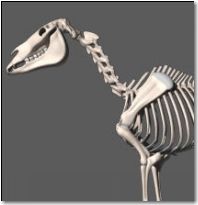
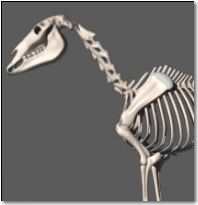
The line of function of the nuchal ligament, from the withers to the back of the second cervical vertebra, strongly suggests instead that, lowering the neck and therefore increasing the tension on the nuchal ligament may deepen the lower curve of the cervical alignment sagging the trunk between the shoulder blades.
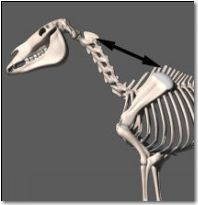
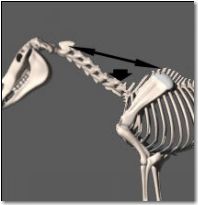
A secondary effect, known as “verticalization” of the dorsal spinous processes further aggravates the problem. “In the living horse, as is also the case in anatomical specimens, the lowering of the neck produces a verticalization of the spinous processes in the wither.” (Jean Marie Denoix, Spinal Biomechanics and Functional Anatomy, 1999)
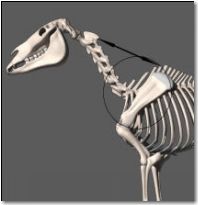
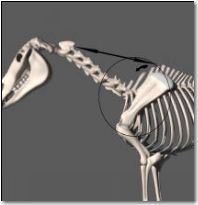
The technique evidently increases the weight on the forelegs. In fact, I the late 1980, when Nicole Uphoff was preparing Rembrandt for the 1988 Seoul Olympics, the over-flexion of the neck was already in vogue. It was not the dramatic hyper-flexion of the upper neck that is practiced today. It was more an overall flexion of the whole neck which was referred to as “deep work”. There was no more rational explanation at that time than there is today for the hyper-flexion of the upper neck. It was just something riders were doing hoping that it would help them to win. One of the theories was precisely that the deep work increased the load on the forelegs. “As the rider warms up with the horse’s neck over-flexed, the load on the forelegs increases. When the rider lifts the horse’s neck up before entering the ring, the load on the forelegs lessens and the shoulders exhibit greater freedom at least for the time of the test.” The theory was infantile. The extrinsic muscles of the forelegs adjust instantly to the load. Their adjustments are not retroactive. The difference, if there was one, was more like that of the saying of the man who hits his head against the wall because it feels so good when he stops.
However one looks at it: from the perspective of the main ligaments involved, the muscular system, the kinematics of the limbs, or the biomechanical properties of the vertebral column, there is no advantage in over-flexing the horse’s upper neck. Not one of the scientific studies has found any athletic advantage in over-flexing the horse’s upper neck. I am referring of course to the scientific investigations that have not been financed by the Rollkur proponents. The question is therefore why riders are using this technique?
In 1995, the great Reiner Klimke wrote, “Now we breed only Rembrandts and Gigolos, if we can- and therefore we have developed our sport. The riding has not become better.” Klimke refers to Rembrandt and Gigolo because they were at this time the best horses in the world. The prediction of the late Olympic champion was accurate. Breeding programs have since given births to even more extraordinary horses. However, with superior talent comes tremendous power, great intelligence and high spirit; so much of these qualities that conventional training techniques are overwhelmed. Instead of upgrading their equestrian education to the quality level of their horses, riders and trainers practicing the hyper-flexion of the upper neck are downgrading their horses to ultimate domination by placing their horse in a situation where they have physically no way out. Upper neck muscles as well as higher segments of the nuchal ligament are weak; and once trapped in this posture, either subdued by physical pain or because they have no way out, or both, the horse’s brain shuts off as a survival reflex. They execute the moves mechanically, focusing on staying alive.
This is a failure of Olympic dimension. The horses, the science and the tradition working together had the opportunity to further the standards of excellence. Humans as well as equine athletes come with superior predispositions but they still have to learn the subtle coordination of their physique that optimizes their talent. The sophistication made possible by an actual understanding of the horse’s vertebral column biomechanical properties demands greater engagement of the horse’s intelligence.
Submissive techniques belong to the equestrian education of the medieval age. There are approximately 344 articular surfaces in the horse’ vertebral column and their precise orchestration can only be coordinated by the horse’s brain with the rider’s assistance. Guiding the horse’s brain toward a physical orchestration far more elaborate than the limits of natural reflexes and that the horse mental processing could not conceive without the support of the rider’s analysis, is the partnership that classic authors and modern science are viewing as the ultimate achievement. Horses are ready, so are a large majority of riders and trainers.
A major obstacle, however, needs to be eradicated: an erroneous theory, which like a drug is feeding the dream that one will be winning while simultaneously destroying the partner without which one cannot win. No hope can be expected from the governing body. The F.E.I. has been efficiently lobbied and, in regard of hyper-flexion of the horse’s upper neck has taken a non-committed position. It was clever for the lawyers of the Rollkur’s proponents to raise the question, “Is the Rollkur painful for the horse.” Pain cannot be scientifically measured or specifically attributed to a neck posture. The most common way to be aware of pain is facial expression and body language. The suffering, the desperation, the supplication, and then, even worse, the absence of any emotion visible in the facial expression and eye of the horse working with the upper neck overly flexed have outraged millions of riders and trainers all over the world. The awkwardness and discomfort of the horses’ body language have disgusted practically every rider and trainer possessing ethics and decency.
Enough is enough, but the response has to come from each individual.
16 days into the petition we have received 1218 signatures. This number is as today November 1st, 2009. In fact, in the time needed to write this line the number has rise to 1231. Basically we are averaging 100 signatures a day. There are currently several petitions going on about the same subject and they all are equally successful. There are millions of riders all over the world who are outraged by the practice. James Crook wrote, “A man who wants to lead the orchestra must turn his back on the crowd.” Perhaps there, is a good idea. Educating efficiently the horse’s vertebral column is about orchestrating numerous and minute muscles contractions. Such sophisticated orchestration cannot be done submitting the horse to ineffective principles. Each one of us would not hesitate to stand up and applaud a great performance. Like -wise, each one of us should not hesitate to stand up for the horse and turn our back on the ring or even leave the show area when a rider practicing the hyper-flexion of the horse’s upper neck enters the scene. If 10 or 50 or 100 spectators stand up and turn their back on the ring or even leave the ring area, perhaps riders, trainers, judges, stewards and even the governing body might realize that if they do not respect horses, they may have to pack and go because a very large body of real horse persons will not let go. Jean Luc Cornille©2009 Images by Helyn Cornille
Your Response
Helyn & Jean Luc:
I read the article when I was called into an emergency hip replacement tonight . After reading the article I have one word in response...INCREDIBLE!!! I have just a few questions about the article which I will ask you when I see you Tuesday.....things relating to the 60 degree angle and how it relates to Big Boy. Jean Luc and Helyn I mean it when I say this article was fantastic. It was well researched, easy to understand thanks to the pictures and definitions which taught me what I need to know. I let the physicians read it also...they could not believe the level of science involved in the equestrian world and thought the article was "solid" in scientific explanation. They really enjoyed the article. I am heading home now...and will read the next article hopefully tomorrow.
Thanks for all your hard work in educating us whacky horse people.
Peace,
Cindy


